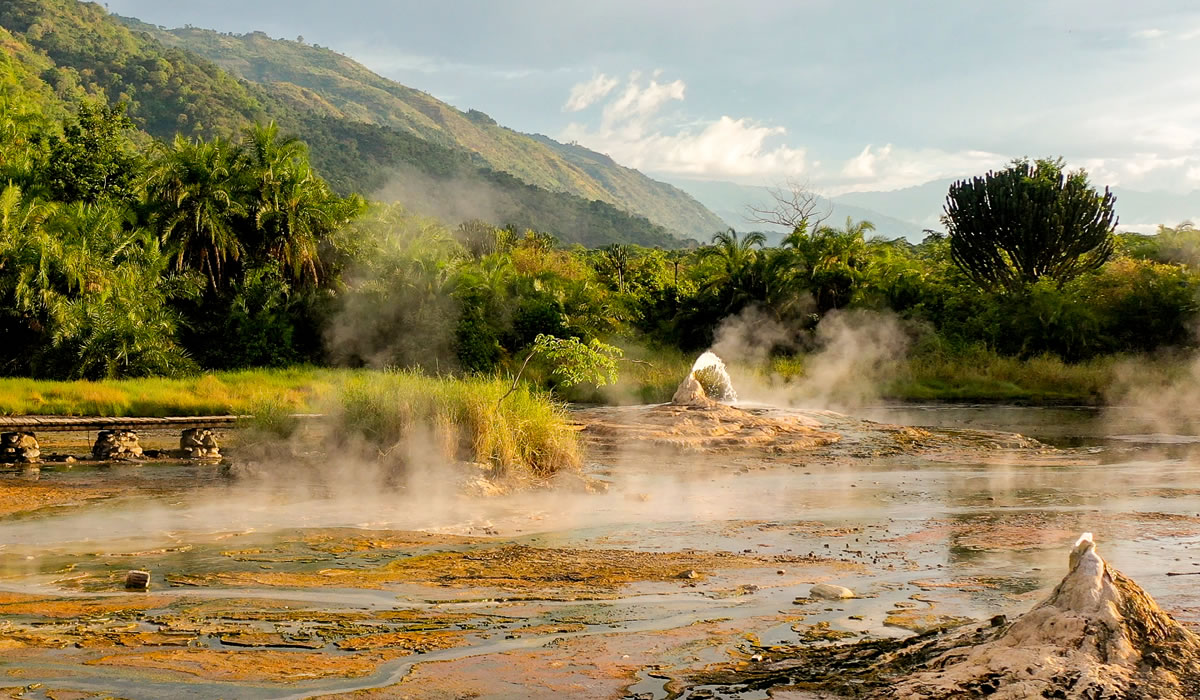Semuliki National Park is one of Uganda’s most fascinating and unique protected areas, renowned for its incredible biodiversity, hot springs, and position as a true ecological bridge between central and eastern Africa. Located in the western part of Uganda in Bundibugyo District, the park stretches across 220 square kilometers and lies at the base of the Albertine Rift Valley along the border with the Democratic Republic of Congo. Established as a national park in 1993, Semuliki is Uganda’s only lowland tropical rainforest park, an extension of the vast Ituri Forest of the Congo Basin, making it ecologically distinct from other protected areas in the country. Its rich habitats, cultural diversity, and unusual natural features make it a must-visit destination for adventurous travelers seeking off-the-beaten-track experiences.

The park is covered predominantly by dense lowland rainforest, interspersed with swampy areas, grasslands, and rivers. This unique ecosystem supports an incredible variety of life, earning it a reputation as one of the most biodiverse spots in Uganda. More than 441 recorded bird species and 53 mammal species are found here, including several that are typical of the Congo Basin forests and are rarely seen elsewhere in East Africa. The park’s terrain is mostly flat, unlike the mountainous landscapes of the Rwenzori region nearby, making it suitable for both casual nature walks and more immersive forest expeditions.
One of the most famous attractions in Semuliki National Park is its birdlife. The park is considered a birder’s paradise, particularly because of the presence of central African species that cannot be found in any other part of Uganda. Birdwatchers can look out for species such as the Congo serpent eagle, long-tailed hawk, yellow-throated cuckoo, African dwarf kingfisher, white-crested hornbill, and Nkulengu rail. The park’s riverine habitats, forest edges, and swampy areas provide perfect birding grounds, making Semuliki an essential stop for ornithologists and bird enthusiasts alike.
Wildlife viewing in Semuliki is equally rewarding. Although the thick forest cover can make spotting animals more challenging than in Uganda’s savannah parks, the park is home to chimpanzees, forest elephants, pygmy hippos, buffaloes, civets, and several types of antelope, such as duikers and bushbucks. Nocturnal game drives, a unique activity in Semuliki, allow visitors to encounter night dwellers like genet cats, white-tailed mongooses, and owls. The presence of primates adds to the park’s appeal, with black-and-white colobus monkeys, red-tailed monkeys, baboons, and vervet monkeys regularly seen along the trails.
The hot springs of Semuliki National Park are another highlight that attract both local and international visitors. The Sempaya Hot Springs, located in the Sempaya area of the park, are divided into the “Male” and “Female” springs, each with its own cultural and historical significance. The female hot spring, Nyasimbi, features a geyser that spews boiling water up to two meters into the air, with surrounding pools hot enough to cook food such as eggs and plantains, an activity often enjoyed by visitors. The male hot spring, Bintente, is a larger pool with a more subdued appearance but is equally fascinating. These hot springs are not only natural wonders but also carry deep cultural meaning for the local communities, who associate them with ancestral spirits and rituals.
Cultural experiences are integral to a visit to Semuliki National Park. The region is home to several ethnic groups, including the Bamba, Bakonzo, and Batwa people. The Batwa, sometimes referred to as pygmies, are believed to be the original inhabitants of the forest, and they have retained much of their traditional hunter-gatherer lifestyle. Community tours allow visitors to interact with these groups, learning about their customs, dances, music, and ways of life. Visiting local homesteads and attending cultural performances offers valuable insight into the human heritage of the region, complementing the natural attractions of the park.
Nature walks are one of the best ways to explore Semuliki’s hidden treasures. Guided walks through the forest reveal its dense canopy, towering trees, and fascinating plant life, some of which have medicinal and cultural significance. The Kirumia Trail, a 13-kilometer path that leads to the Semuliki River, is popular with birdwatchers and hikers seeking a full-day adventure. Shorter trails around the Sempaya area offer opportunities to spot primates, butterflies, and birds while enjoying the serene rainforest environment. Walking safaris also provide opportunities to learn about the unique flora that thrives in the tropical climate, including tree species that are characteristic of the Congo Basin.
The Semuliki River, which meanders along the park’s western edge, is another key feature. This river, a major tributary of the Congo River, is slow-moving and flanked by swampy vegetation. It is an important ecological lifeline, supporting numerous species of fish, amphibians, and birds. Its floodplains and wetlands are particularly rich in biodiversity, making them essential habitats within the park. Boat excursions may sometimes be arranged along parts of the river, offering another perspective of the park’s landscapes and wildlife.
Accommodation options for visitors to Semuliki National Park range from budget to midrange lodges, with some facilities located inside the park and others in nearby Bundibugyo or Fort Portal. Popular choices include Semuliki Safari Lodge, which offers luxury tented camps and cottages with stunning views of the Rift Valley, and Ntoroko Game Lodge on the shores of Lake Albert, which provides access to both the park and lake-based activities. For budget travelers, there are guesthouses and community-run campsites that provide affordable and authentic stays close to the park’s entrance.
Getting to Semuliki National Park is relatively straightforward. By road, it is about 380 kilometers from Kampala, Uganda’s capital, a journey that takes 6 to 7 hours via Fort Portal. The road trip itself is scenic, passing through rolling hills, tea plantations, and the foothills of the Rwenzori Mountains. For those who prefer faster access, charter flights can be arranged from Entebbe or Kajjansi to Semuliki Airstrip near Bundibugyo or to Kasese, followed by a short drive to the park.
The best time to visit Semuliki National Park is during the dry seasons, from December to February and from June to September. During these months, the forest trails are easier to navigate, and wildlife sightings are more frequent around the water sources. However, as a lowland rainforest, Semuliki receives rainfall throughout the year, which contributes to its lush vegetation and biodiversity. Visitors should be prepared for wet conditions at any time of year, carrying waterproof clothing and sturdy hiking boots for forest walks.
Conservation is at the heart of Semuliki National Park’s management. The Uganda Wildlife Authority, which oversees the park, works closely with local communities to promote eco-tourism and reduce human-wildlife conflict. Revenue-sharing programs ensure that communities benefit directly from tourism, encouraging their participation in conservation. Despite challenges such as habitat loss and encroachment, Semuliki remains a vital refuge for species that are globally threatened, and efforts are ongoing to safeguard its unique ecosystems.
In conclusion, Semuliki National Park is a hidden gem in Uganda’s tourism landscape, offering an authentic rainforest experience unlike any other in the country. From the bubbling hot springs and rich birdlife to cultural encounters with local communities and the chance to explore Congo Basin ecosystems, the park provides a blend of natural and cultural attractions that appeal to adventurous travelers. Its biodiversity, coupled with its off-the-beaten-track location, ensures that visitors experience a side of Uganda that is wild, raw, and unforgettable. Whether you are a birder, a nature lover, a cultural explorer, or simply someone seeking new horizons, Semuliki National Park promises a unique journey into the heart of Africa’s equatorial rainforest.
